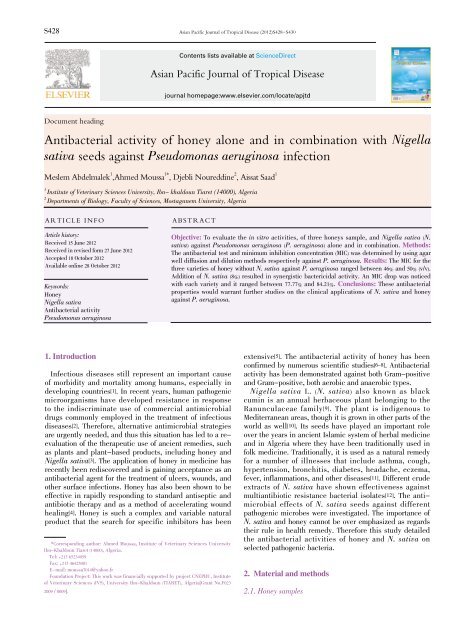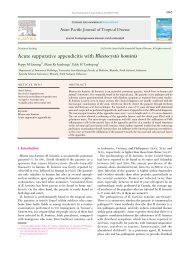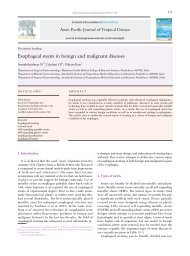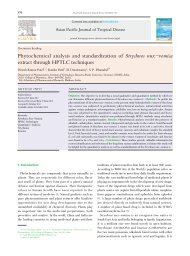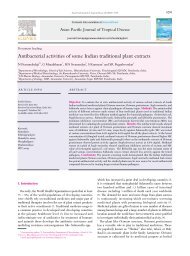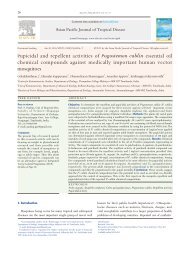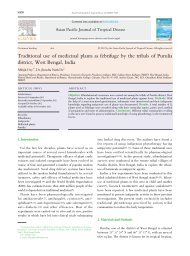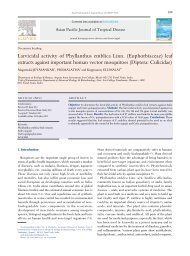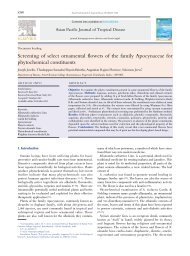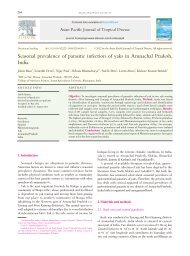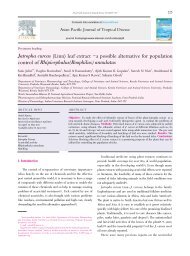Antibacterial activity of honey alone and in combination with Nigella ...
Antibacterial activity of honey alone and in combination with Nigella ...
Antibacterial activity of honey alone and in combination with Nigella ...
Create successful ePaper yourself
Turn your PDF publications into a flip-book with our unique Google optimized e-Paper software.
S428<br />
Document head<strong>in</strong>g<br />
Asian Pacific Journal <strong>of</strong> Tropical Disease (2012)S428-S430<br />
Asian Pacific Journal <strong>of</strong> Tropical Disease<br />
journal homepage:www.elsevier.com/locate/apjtd<br />
<strong>Antibacterial</strong> <strong>activity</strong> <strong>of</strong> <strong>honey</strong> <strong>alone</strong> <strong>and</strong> <strong>in</strong> comb<strong>in</strong>ation <strong>with</strong> <strong>Nigella</strong><br />
sativa seeds aga<strong>in</strong>st Pseudomonas aerug<strong>in</strong>osa <strong>in</strong>fection<br />
Meslem Abdelmalek 1 ,Ahmed Moussa 1* , Djebli Nouredd<strong>in</strong>e 2 , Aissat Saad 1<br />
1 Institute <strong>of</strong> Veter<strong>in</strong>ary Sciences University, Ibn- khaldoun Tiaret (14000), Algeria<br />
2 Departments <strong>of</strong> Biology, Faculty <strong>of</strong> Sciences, Mostaganem University, Algeria<br />
ARTICLE INFO ABSTRACT<br />
Article history:<br />
Received 15 June 2012<br />
Received <strong>in</strong> revised form 27 June 2012<br />
Accepted 18 October 2012<br />
Available onl<strong>in</strong>e 28 October 2012<br />
Keywords:<br />
Honey<br />
<strong>Nigella</strong> sativa<br />
<strong>Antibacterial</strong> <strong>activity</strong><br />
Pseudomonas aerug<strong>in</strong>osa<br />
1. Introduction<br />
Infectious diseases still represent an important cause<br />
<strong>of</strong> morbidity <strong>and</strong> mortality among humans, especially <strong>in</strong><br />
develop<strong>in</strong>g countries[1]. In recent years, human pathogenic<br />
microorganisms have developed resistance <strong>in</strong> response<br />
to the <strong>in</strong>discrim<strong>in</strong>ate use <strong>of</strong> commercial antimicrobial<br />
drugs commonly employed <strong>in</strong> the treatment <strong>of</strong> <strong>in</strong>fectious<br />
diseases[2]. Therefore, alternative antimicrobial strategies<br />
are urgently needed, <strong>and</strong> thus this situation has led to a reevaluation<br />
<strong>of</strong> the therapeutic use <strong>of</strong> ancient remedies, such<br />
as plants <strong>and</strong> plant-based products, <strong>in</strong>clud<strong>in</strong>g <strong>honey</strong> <strong>and</strong><br />
<strong>Nigella</strong> sativa[3]. The application <strong>of</strong> <strong>honey</strong> <strong>in</strong> medic<strong>in</strong>e has<br />
recently been rediscovered <strong>and</strong> is ga<strong>in</strong><strong>in</strong>g acceptance as an<br />
antibacterial agent for the treatment <strong>of</strong> ulcers, wounds, <strong>and</strong><br />
other surface <strong>in</strong>fections. Honey has also been shown to be<br />
effective <strong>in</strong> rapidly respond<strong>in</strong>g to st<strong>and</strong>ard antiseptic <strong>and</strong><br />
antibiotic therapy <strong>and</strong> as a method <strong>of</strong> accelerat<strong>in</strong>g wound<br />
heal<strong>in</strong>g[4]. Honey is such a complex <strong>and</strong> variable natural<br />
product that the search for specific <strong>in</strong>hibitors has been<br />
*Correspond<strong>in</strong>g author: Ahmed Moussa, Institute <strong>of</strong> Veter<strong>in</strong>ary Sciences University<br />
Ibn-Khaldoun Tiaret (14000), Algeria.<br />
Tel: +213 65234059<br />
Fax: +213 46425001<br />
E-mail: moussa7014@yahoo.fr<br />
Foundation Project: This work was f<strong>in</strong>ancially supported by project CNEPRU, Institute<br />
<strong>of</strong> Veter<strong>in</strong>ary Sciences (IVS), University Ibn-Khaldoun (TIARET), Algeria[Grant No.F023<br />
2009 / 0009].<br />
Contents lists available at ScienceDirect<br />
Objective: To evaluate the <strong>in</strong> vitro activities, <strong>of</strong> three <strong>honey</strong>s sample, <strong>and</strong> <strong>Nigella</strong> sativa (N.<br />
sativa) aga<strong>in</strong>st Pseudomonas aerug<strong>in</strong>osa (P. aerug<strong>in</strong>osa) <strong>alone</strong> <strong>and</strong> <strong>in</strong> comb<strong>in</strong>ation. Methods:<br />
The antibacterial test <strong>and</strong> m<strong>in</strong>imum <strong>in</strong>hibition concentration (MIC) was determ<strong>in</strong>ed by us<strong>in</strong>g agar<br />
well diffusion <strong>and</strong> dilution methods respectively aga<strong>in</strong>st P. aerug<strong>in</strong>osa. Results: The MIC for the<br />
three varieties <strong>of</strong> <strong>honey</strong> <strong>with</strong>out N. sativa aga<strong>in</strong>st P. aerug<strong>in</strong>osa ranged between 46% <strong>and</strong> 50% (v/v).<br />
Addition <strong>of</strong> N. sativa (8%) resulted <strong>in</strong> synergistic bactericidal <strong>activity</strong>. An MIC drop was noticed<br />
<strong>with</strong> each variety <strong>and</strong> it ranged between 77.77% <strong>and</strong> 84.21%. Conclusions: These antibacterial<br />
properties would warrant further studies on the cl<strong>in</strong>ical applications <strong>of</strong> N. sativa <strong>and</strong> <strong>honey</strong><br />
aga<strong>in</strong>st P. aerug<strong>in</strong>osa.<br />
extensive[5]. The antibacterial <strong>activity</strong> <strong>of</strong> <strong>honey</strong> has been<br />
confirmed by numerous scientific studies[6-8]. <strong>Antibacterial</strong><br />
<strong>activity</strong> has been demonstrated aga<strong>in</strong>st both Gram-positive<br />
<strong>and</strong> Gram-positive, both aerobic <strong>and</strong> anaerobic types.<br />
<strong>Nigella</strong> sativa L. (N. sativa) also known as black<br />
cum<strong>in</strong> is an annual herbaceous plant belong<strong>in</strong>g to the<br />
Ranunculaceae family[9]. The plant is <strong>in</strong>digenous to<br />
Mediterranean areas, though it is grown <strong>in</strong> other parts <strong>of</strong> the<br />
world as well[10]. Its seeds have played an important role<br />
over the years <strong>in</strong> ancient Islamic system <strong>of</strong> herbal medic<strong>in</strong>e<br />
<strong>and</strong> <strong>in</strong> Algeria where they have been traditionally used <strong>in</strong><br />
folk medic<strong>in</strong>e. Traditionally, it is used as a natural remedy<br />
for a number <strong>of</strong> illnesses that <strong>in</strong>clude asthma, cough,<br />
hypertension, bronchitis, diabetes, headache, eczema,<br />
fever, <strong>in</strong>flammations, <strong>and</strong> other diseases[11]. Different crude<br />
extracts <strong>of</strong> N. sativa have shown effectiveness aga<strong>in</strong>st<br />
multiantibiotic resistance bacterial isolates[12]. The antimicrobial<br />
effects <strong>of</strong> N. sativa seeds aga<strong>in</strong>st different<br />
pathogenic microbes were <strong>in</strong>vestigated. The importance <strong>of</strong><br />
N. sativa <strong>and</strong> <strong>honey</strong> cannot be over emphasized as regards<br />
their rule <strong>in</strong> health remedy. Therefore this study detailed<br />
the antibacterial activities <strong>of</strong> <strong>honey</strong> <strong>and</strong> N. sativa on<br />
selected pathogenic bacteria.<br />
2. Material <strong>and</strong> methods<br />
2.1. Honey samples
Dur<strong>in</strong>g the 2009 flower<strong>in</strong>g seasons, three <strong>honey</strong> samples<br />
were gathered <strong>and</strong> provided by various bee-keepers from<br />
two area different from the Algeria west. These <strong>honey</strong><br />
samples were aseptically collected <strong>in</strong> sterile screwed cups<br />
<strong>and</strong> kept <strong>in</strong> a cool <strong>and</strong> dry place (at room temperature)<br />
overnight before they were f<strong>in</strong>ally transported to the<br />
laboratory.<br />
2.2. Plant materials <strong>and</strong> preparation<br />
N. sativa seeds were obta<strong>in</strong>ed from the local seed supplier.<br />
The seeds were crushed manually <strong>in</strong> a mortar <strong>with</strong> a pestle.<br />
A volume <strong>of</strong> 100 mL <strong>of</strong> distilled water was added to 20 g <strong>of</strong><br />
dry powder. It was vortexed cont<strong>in</strong>uously until there was<br />
no further change <strong>in</strong> color <strong>of</strong> the solution. This solution was<br />
centrifuged at 800 g for 15 m<strong>in</strong>. The supernatant (brownishorange<br />
<strong>in</strong> colour) was filtered through Whatman filter No. 4<br />
<strong>and</strong> stored at 4 曟 <strong>in</strong> sterile tubes until use.<br />
2.3. Test organism<br />
Micro-organism was obta<strong>in</strong>ed from the Department <strong>of</strong><br />
Biomedic<strong>in</strong>e, Institute <strong>of</strong> Veter<strong>in</strong>ary Science University Ibn-<br />
Khaldun, Algeria.<br />
2.4. Preparation <strong>of</strong> bacterial <strong>in</strong>oculum<br />
Stock cultures were ma<strong>in</strong>ta<strong>in</strong>ed at 4 曟 on slopes <strong>of</strong> nutrient<br />
agar. Active cultures for experiments were prepared by<br />
transferr<strong>in</strong>g a loop full <strong>of</strong> cells from each stock culture <strong>of</strong><br />
Pseudomonas aerug<strong>in</strong>osa (P. aerug<strong>in</strong>osa) to test tubes <strong>of</strong><br />
nutrient agar medium <strong>and</strong> <strong>in</strong>cubat<strong>in</strong>g <strong>with</strong>out agitation for 24<br />
h at 37 曟. The cultures were diluted <strong>with</strong> fresh nutrient agar<br />
broth to achieve optical densities correspond<strong>in</strong>g to 2.0 伊 10 6<br />
colony form<strong>in</strong>g units (CFU/mL)[13].<br />
2.5. <strong>Antibacterial</strong> assay<br />
4. Discussion<br />
P. aerug<strong>in</strong>osa is a major nosocomial pathogen, particularly<br />
dangerous to cystic fibrosis patients <strong>and</strong> populations<br />
hav<strong>in</strong>g weak immune system. In wounds, P. aerug<strong>in</strong>osa<br />
has emerged as a multidrug-resistant organism that gives<br />
rise to persistent <strong>in</strong>fections <strong>in</strong> burns patients <strong>and</strong> chronic<br />
venous leg ulcers[14-16]. Novel antimicrobial <strong>in</strong>terventions<br />
are needed. Natural medic<strong>in</strong>al products have been used<br />
for millennia to treat multiple ailments. Although many<br />
have been superseded by conventional pharmaceutical<br />
approaches, there is currently resurgence <strong>of</strong> <strong>in</strong>terest by<br />
physicians <strong>in</strong> natural products. N. sativa seeds play an<br />
Meslem Abdelmalek et al./Asian Paicfic Journal <strong>of</strong> Tropical Disease (2012)S428-S430 S429<br />
<strong>Antibacterial</strong> <strong>activity</strong> was measured us<strong>in</strong>g a well diffusion<br />
method accord<strong>in</strong>g to the National Committee for Cl<strong>in</strong>ical<br />
Laboratory St<strong>and</strong>ard (NCCLS 1999). Briefly, Petri plates<br />
conta<strong>in</strong><strong>in</strong>g 20 mL <strong>of</strong> nutritive agar medium were <strong>in</strong>oculated<br />
<strong>with</strong> a 24 h culture <strong>of</strong> the bacterial stra<strong>in</strong>s. Wells (8 mm<br />
diameter) were punched <strong>in</strong> the agar <strong>and</strong> filled <strong>with</strong> 30 毺L<br />
<strong>of</strong> N. sativa or <strong>honey</strong>. The second step <strong>of</strong> a mixture <strong>of</strong> 30 毺<br />
L N. sativa <strong>and</strong> <strong>honey</strong> has been <strong>in</strong>troduced <strong>in</strong>to the wells.<br />
Triplicates <strong>of</strong> each plate have been done. The plates were<br />
<strong>in</strong>cubated at 37 曟 for 24 h. The antibacterial <strong>activity</strong> was<br />
assessed by measur<strong>in</strong>g the diameter <strong>of</strong> the area <strong>in</strong> which<br />
bacterial growth was <strong>in</strong>hibited around the well. The average<br />
<strong>of</strong> three replicates for <strong>honey</strong>, N. sativa, <strong>and</strong> comb<strong>in</strong>ation<br />
were calculated.<br />
The controls were set up <strong>with</strong> equivalent quantities <strong>of</strong><br />
water.<br />
2.5.1. M<strong>in</strong>imum <strong>in</strong>hibitory concentration measurement <strong>of</strong> N.<br />
sativa <strong>and</strong> <strong>honey</strong> samples<br />
Increased concentrations <strong>of</strong> <strong>honey</strong> (1-50% vol/vol) <strong>and</strong><br />
N. sativa from 2%, 4%, 6% <strong>and</strong> 8% were <strong>in</strong>corporated <strong>in</strong>to<br />
nutritive agar media to test their efficiency aga<strong>in</strong>st P.<br />
aerug<strong>in</strong>osa. Each plate <strong>with</strong> f<strong>in</strong>al volume <strong>of</strong> <strong>honey</strong> <strong>and</strong><br />
media <strong>of</strong> 5 mL was <strong>in</strong>oculated <strong>and</strong> <strong>in</strong>cubated at 37 曟 for 24<br />
h. The MIC was determ<strong>in</strong>ed by f<strong>in</strong>d<strong>in</strong>g the plates <strong>with</strong> the<br />
lowest concentration <strong>of</strong> <strong>honey</strong> on which the stra<strong>in</strong> didn’t<br />
grow. All MIC values were expressed <strong>in</strong> % (v/v).<br />
3. Results<br />
Table 1<br />
Comb<strong>in</strong>ed <strong>activity</strong> <strong>of</strong> N. sativa <strong>and</strong> the three varieties <strong>of</strong> <strong>honey</strong> aga<strong>in</strong>st P. aerug<strong>in</strong>osa.<br />
The additive effect between <strong>honey</strong> <strong>and</strong> N. sativa as regards<br />
our three varieties <strong>of</strong> <strong>honey</strong>s studied aga<strong>in</strong>st P. aerug<strong>in</strong>osa<br />
showed that the MIC for the three varieties <strong>of</strong> <strong>honey</strong>s were by<br />
decreas<strong>in</strong>g order <strong>of</strong> effect; 3% (v/v) <strong>and</strong> 12% (w/v), 2% (v/v) <strong>and</strong><br />
14% (w/v), <strong>and</strong> 2% (v/v) <strong>and</strong> 10% (w/v).<br />
Honeysample Honey only % (vol/vol) MIC <strong>of</strong> the mixture <strong>of</strong> <strong>honey</strong> <strong>and</strong> N. sativa %(vol/vol) (H:NS) [Honey:NS]<br />
DZ (mm)<br />
MIC DZ (mm) 1% 2% 4% 6% 8%<br />
Honey<br />
MIC drop %<br />
H1 19 4 19 19 19 19 3:12 >4 mm 84.21%<br />
H2 10 6 10 10 10 10 2:14 >6 mm 80.00%<br />
H3 9 5 9 9 9 9 2:10 >6 mm 77.77%<br />
Control (Water) 0 0 0 0 0 0 0:0 0 mm 0.00%<br />
NS: N. sativa.<br />
important role <strong>in</strong> folk medic<strong>in</strong>e <strong>and</strong> some <strong>of</strong> its major<br />
constituents are reported to be pharmacologically active[17].<br />
Phytochemical studies <strong>of</strong> the seeds have revealed the<br />
presence <strong>of</strong> volatile oil (1.5%), fixed oil (37.5%), nigell<strong>in</strong>,<br />
melanth<strong>in</strong>, arabic acid, carvene, carvone, cymene[18],<br />
thymohydroqu<strong>in</strong>one <strong>and</strong> thymoqu<strong>in</strong>one[19]. It has been<br />
reported that crude extracts <strong>and</strong> essential oil possess<br />
antibacterial <strong>activity</strong> aga<strong>in</strong>st several bacteria[20-22].<br />
Several bioactive compounds have been identified<br />
<strong>in</strong> <strong>honey</strong> which contributed to its antibacterial action.<br />
The commonly accepted list <strong>of</strong> contributors <strong>in</strong>clude<br />
osmolarity[23,24], hydrogen peroxide[25], polyphenols[26],<br />
antioxidants[27] antibiotic peptides[28], <strong>and</strong> recently, Maillard<br />
reaction products[27].
S430<br />
Honey <strong>and</strong> N. sativa has been found to possess<br />
antibacterial <strong>activity</strong> <strong>and</strong> this has been attributed to specific<br />
chemicals <strong>in</strong> the <strong>honey</strong> <strong>and</strong> N. sativa[3]. The results <strong>of</strong> this<br />
study show that add<strong>in</strong>g <strong>honey</strong> to N. sativa <strong>in</strong>creases the<br />
antibacterial effect aga<strong>in</strong>st P. aerug<strong>in</strong>osa (Table 1).<br />
Its comb<strong>in</strong>ation <strong>with</strong> N. sativa displayed valued potency<br />
on the test organisms than when used <strong>in</strong> s<strong>in</strong>gle form. This<br />
emphasised that comb<strong>in</strong>ation <strong>of</strong> two or more substances<br />
<strong>with</strong> medic<strong>in</strong>al values could be better if their components<br />
will not cause a reaction that could cause health disaster<br />
than heal<strong>in</strong>g. The exact mechanism <strong>of</strong> comb<strong>in</strong>ation between<br />
medic<strong>in</strong>al plants <strong>and</strong> <strong>honey</strong> requires futher <strong>in</strong>vestigation.<br />
It is therefore concluded that <strong>honey</strong> <strong>and</strong> N. sativa<br />
comb<strong>in</strong>ations due to their synergistic effect have potential to<br />
be used <strong>in</strong> the treatment <strong>of</strong> P. aerug<strong>in</strong>osa <strong>in</strong>fections.<br />
Conflict <strong>of</strong> <strong>in</strong>terest statement<br />
We declare that we have no conflict <strong>of</strong> <strong>in</strong>terest.<br />
Acknowledgements<br />
Authors thank Staff <strong>of</strong> Tiaret University for provid<strong>in</strong>g<br />
material.<br />
References<br />
[1] Ghaleb A, Yousef S, Kamel A. Effect <strong>of</strong> ethanolic extract <strong>of</strong><br />
Ecballium elaterium aga<strong>in</strong>st Staphylococcus aureus <strong>and</strong> C<strong>and</strong>ida<br />
albicans. Asian Pac J Trop Biomed 2011; 1: 456-460.<br />
[2] Elumalai EK, Ramach<strong>and</strong>ran M, Thirumalai1 T, V<strong>in</strong>othkumar<br />
P. <strong>Antibacterial</strong> <strong>activity</strong> <strong>of</strong> various leaf extracts <strong>of</strong> Merremia<br />
emarg<strong>in</strong>ata. Asian Pac J Trop Biomed 2011; 1: 406-408.<br />
[3] Hasan A. A, Balkees A Bakhotmah, Laïd B. In vitro susceptibility<br />
<strong>of</strong> diabetic wound bacteria to mixtures <strong>of</strong> <strong>honey</strong>, Commiphora<br />
molmol <strong>and</strong> <strong>Nigella</strong> sativa. The Open Nutraceuticals Journal 2011;<br />
4: 172-175.<br />
[4] Adewumi AA, Ogunj<strong>in</strong>mi AA. The heal<strong>in</strong>g potential <strong>of</strong> <strong>honey</strong> <strong>and</strong><br />
propolis lotion on septic wounds. Asian Pac J Trop Biomed 2011;<br />
1: S55-S57.<br />
[5] Manisha Deb M, Shyamapada M. Honey: its medic<strong>in</strong>al property<br />
<strong>and</strong> antibacterial <strong>activity</strong>. Asian Pac J Trop Biomed 2011; 1:<br />
154-160.<br />
[6] M<strong>and</strong>al S, Deb M<strong>and</strong>al M, Pal NK, Saha K. <strong>Antibacterial</strong> <strong>activity</strong> <strong>of</strong><br />
<strong>honey</strong> aga<strong>in</strong>st cl<strong>in</strong>ical isolates <strong>of</strong> Escherichia coli, Pseudomonas<br />
aerug<strong>in</strong>osa <strong>and</strong> Salmonella enterica serovar Typhi. Asian Pac J<br />
Trop Med 2010; 3: 961-964.<br />
[7] Sherlock O, Dolan A, Athman R, Power A, Geth<strong>in</strong> G, Cowman<br />
S, et al. Comparison <strong>of</strong> the antimicrobial <strong>activity</strong> <strong>of</strong> ulmo <strong>honey</strong><br />
from Chile <strong>and</strong> manuka <strong>honey</strong> aga<strong>in</strong>st methicill<strong>in</strong>-resistant<br />
Staphylococcus aureus, Escherichia coli <strong>and</strong> Pseudomonas<br />
aerug<strong>in</strong>osa. BMC Complement Alternat Med 2010; 10: 47.<br />
[8] Hanene JH, Bochra K, Guido F, Am<strong>in</strong>a B, Touhami M. Chemical<br />
composition, antimicrobial potential aga<strong>in</strong>st cariogenic bacteria<br />
<strong>and</strong> cytotoxic <strong>activity</strong> <strong>of</strong> Tunisian <strong>Nigella</strong> sativa essential oil <strong>and</strong><br />
thymoqu<strong>in</strong>one. Food Chem 2011; 129: 1469-1474.<br />
[9] Ali K, Hasanah MG, Ali Y, Yogesh<strong>in</strong>i R, Ali G. Physicochemical<br />
characteristics <strong>of</strong> <strong>Nigella</strong> seed (<strong>Nigella</strong> sativa L.) oil as affected<br />
by different extraction methods. J Am Oil Chem Soc 2011; 88:<br />
533-540.<br />
Meslem Abdelmalek et al./Asian Paicfic Journal <strong>of</strong> Tropical Disease (2012)S428-S430<br />
[10] Ali BH, Blunden G. Pharmacological <strong>and</strong> toxicological properties<br />
<strong>of</strong> <strong>Nigella</strong> sativa. Phytother Res 2003; 17: 299-305.<br />
[11] Morsi NM. Antimicrobial effect <strong>of</strong> crude extracts <strong>of</strong> <strong>Nigella</strong> sativa<br />
on multiple antibiotics-resistant bacteria. Acta Microbiol Pol<br />
2000; 49(1): 63-74.<br />
[12] Bissa S, Av<strong>in</strong>ash B, Bohra A. <strong>Antibacterial</strong> potential <strong>of</strong> three<br />
naked-seeded (Gymnosperum) plants. Nat Prod Rad 2008: 7(5):<br />
420-425.<br />
[13] National Committee for Cl<strong>in</strong>ical Laboratory St<strong>and</strong>ards<br />
(NCCLS). Performance st<strong>and</strong>ards for antimicrobial disk <strong>and</strong><br />
dilution susceptibility tests for bacteria isolated from animals.<br />
Pennsylvania, USA: NCCLS; 1999.<br />
[14] Branski LK, Al-Mousawi A, Rivero H, Jeschke MG, Sanford AP,<br />
Herndon DN. Emerg<strong>in</strong>g <strong>in</strong>fections <strong>in</strong> burns. Surg Infect 2009; 10(5):<br />
389-397.<br />
[15] Keen EF 3rd, Rob<strong>in</strong>son BJ, Hospenthal DR, Aldous WK, Wolf<br />
SE, Chung KK, et al. Prevalence <strong>of</strong> multidrugresistant organisms<br />
recovered at a military burn center. Burns 2010; 36(6): 819-825.<br />
[16] Fazli M, Bjarnsholt T, Kirketerp-Møller K, Jørgensen B, Andersen<br />
AS, Krogfelt KA, Givskov M, Tolker-Nielsen T. Nonr<strong>and</strong>om<br />
distribution <strong>of</strong> Pseudomonas aerug<strong>in</strong>osa <strong>and</strong> Staphylococcus<br />
aureus <strong>in</strong> chronic wounds. J Cl<strong>in</strong> Microbiol 2009; 47(12): 4084-4089.<br />
[17] Suresh Kumar TV, Negi PS, <strong>and</strong> Udaya Sankar K. <strong>Antibacterial</strong><br />
Activity <strong>of</strong> <strong>Nigella</strong> sativa L. Seed Extracts. Br J Pharmacol Toxicol<br />
2010; 1(2): 96-100.<br />
[18] Nadkarni K. Crocus sativus, <strong>Nigella</strong> sativa. In: Nadkarni KM,<br />
editor. Indian materia medica. India: Popular Prakashan; 1976, p.<br />
386-411.<br />
[19] Houghton PJ, Zarka R, de las Heras B, Hoult JR. Fixed oil <strong>of</strong><br />
<strong>Nigella</strong> sativa <strong>and</strong> derived thymoqu<strong>in</strong>one <strong>in</strong>hibit eicosanoid<br />
generation <strong>in</strong> leukocytes <strong>and</strong> membrane lipid peroxidation.<br />
Planta Medica 1995; 61(1): 33-36.<br />
[20] Ali NA, Julich WD, Kusnick C, L<strong>in</strong>dequist U. Screen<strong>in</strong>g <strong>of</strong> Yemeni<br />
medic<strong>in</strong>al plants for antibacterial <strong>and</strong> cytotoxic activities. J<br />
Ethnopharmacol 2001; 74(2): 173-179.<br />
[21] El-Kamali HH, Ahmed AH, Mohammed AAM. <strong>Antibacterial</strong><br />
properties <strong>of</strong> essential oils from <strong>Nigella</strong> sativa seeds, Cymbopogon<br />
citratus leaves <strong>and</strong> Pulicaria undulata aerial parts. Fitoterapia<br />
1998; 69: 77-78.<br />
[22] Mouhajir F, Pedersen JA, Rejdali M, Towers GHN. Antimicrobial<br />
thymohydroqu<strong>in</strong>ones <strong>of</strong> Moroccan <strong>Nigella</strong> sativa seeds detected<br />
by electron sp<strong>in</strong> resonance. Pharm Biol 1999; 37, 391-395.<br />
[23] Wahdan HAL. Causes <strong>of</strong> the antimicrobial <strong>activity</strong> <strong>of</strong> <strong>honey</strong>.<br />
Infection 1998; 26: 26-31.<br />
[24] Bose B. Honey or sugar <strong>in</strong> treatment <strong>of</strong> <strong>in</strong>fected wounds? Lancet<br />
1982; 1(8278): 963.<br />
[25] Brudzynski K, Abubaker K, Miotto D. Unravel<strong>in</strong>g a mechanism <strong>of</strong><br />
<strong>honey</strong> antibacterial action: Polyphenol/H2O2-<strong>in</strong>duced oxidative<br />
effect on bacterial cell growth <strong>and</strong> on DNA degradation. Food<br />
Chem 2012; 133: 329-336.<br />
[26] Aljadi AM, Yus<strong>of</strong>f KM. Isolation <strong>and</strong> identification <strong>of</strong> phenolic<br />
acids <strong>in</strong> Malaysian <strong>honey</strong> <strong>with</strong> antibacterial properties. Turk J<br />
Med Sci 2003; 3: 229-236.<br />
[27] Brudzynski K, Miotto D. Honey melanoid<strong>in</strong>s. Analysis <strong>of</strong> a<br />
composition <strong>of</strong> the high molecular weight melanoid<strong>in</strong> fractions<br />
exhibit<strong>in</strong>g radical scaveng<strong>in</strong>g capacity. Food Chem 2011; 127:<br />
1023-1030.<br />
[28] Kwakman PHS, de Boer L, Ruyter-Spira CP, Creemers-Molenaar<br />
T, Helsper JPFG, V<strong>and</strong>enbroucke-Grauls CMJE, et al. Medicalgrade<br />
<strong>honey</strong> enriched <strong>with</strong> antimicrobial peptide has enhanced<br />
<strong>activity</strong> aga<strong>in</strong>st antibioticresistant pathogens. Eur J Cl<strong>in</strong> Microbiol<br />
Infect Dis 2011; 30: 251-257.


